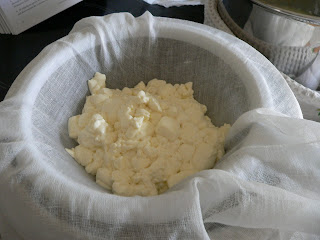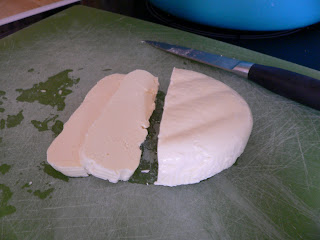We arrived around 9am and enjoyed walking round the well-presented organic food shop - full of fresh fruits and veggies picked from the farm. We had a coffee in the cafe and met Clive, the award-winning-yet-incredibly-humble cheesemaker who would be our teacher for the day.
 |
| How Now!!!! |
Follow me! He said - and so we took a rambling walk through Abbey Home Farm, passing some friendly cows on our way. We followed Clive to where the magic happens - a cheese-making facility full of large-scale cheese gadgets - and instantly my list for Santa was filled with ideas!
Once there, we put on some science-lab looking jackets and sexy smurf shoe covers. Note to self: Must look into obtaining similar garb at home to increase quality (and success rate) of my cheese.
The class was great for beginners as well as people, like me, who may have done some dabbling in the kitchen before. Clive was excellent at explaining things very simply, but then was quite happy to field the 20-30 questions fired at him by me and my fellow classmates in our childlike curiosity of all things cheese.
 |
| Our sage , Clive |
We warmed milk, added the special secret blend of cultures (not so secret in the end as Clive did share with us the list of cultures it includes), and let it stand for a while. With time to kill, Clive offered us a tasting of all the cheese he makes - oh, go on then! One of the cheeses was Dancys Fancy - his award-winning soft-cheese. Instantly a favourite, it was welcome news to find out this was the cheese we were making today (assuming we were suitable pupils).
We next warmed the milk again slightly and added the rennet to ripen the cheese. Since we had more time to wait while the curds separated from the whey, Clive showed us how to make butter. As an aside - butter making was quite interesting to watch as the cream transformed - at one point looking very similar to scrambled eggs. We each had a go at shaping some butter using the grooved butter paddles. (Dropped my butter once which was only 1 more time than anyone else.)
After butters were shaped and stored in the refrigerator (until the end of the course when we could take them home), we checked on the cheese which was ready to be cut. We cut our curds, let them rest for just a bit, gently stirred them with our hands,and then it was time to place the curds into moulds where they will reside until the cheese is ready to be eaten!
We headed in for lunch - made by the organic cafe. It was a hearty vegetarian meal with a large side of Q&A with Clive - he sure had plenty of patience dealing with my many questions. He also showed us where the cheeses are stored and gave us a taste of a few cheddars in different stages of ageing. It was really interesting to compare the mild, simple taste of a 3-month old cheddar with a nearly-ready, strong 16-month old cheddar.
We visited our cheeses, now in moulds, once more to bid them farewell and wish them good luck in the ageing process (which I've been told is where a lot of things go wrong). Clive will look after them until they are ready to be eaten at which point he'll send them to us! With any luck, they'll be ready (and more importantly, tasty) just before Christmas...



















































